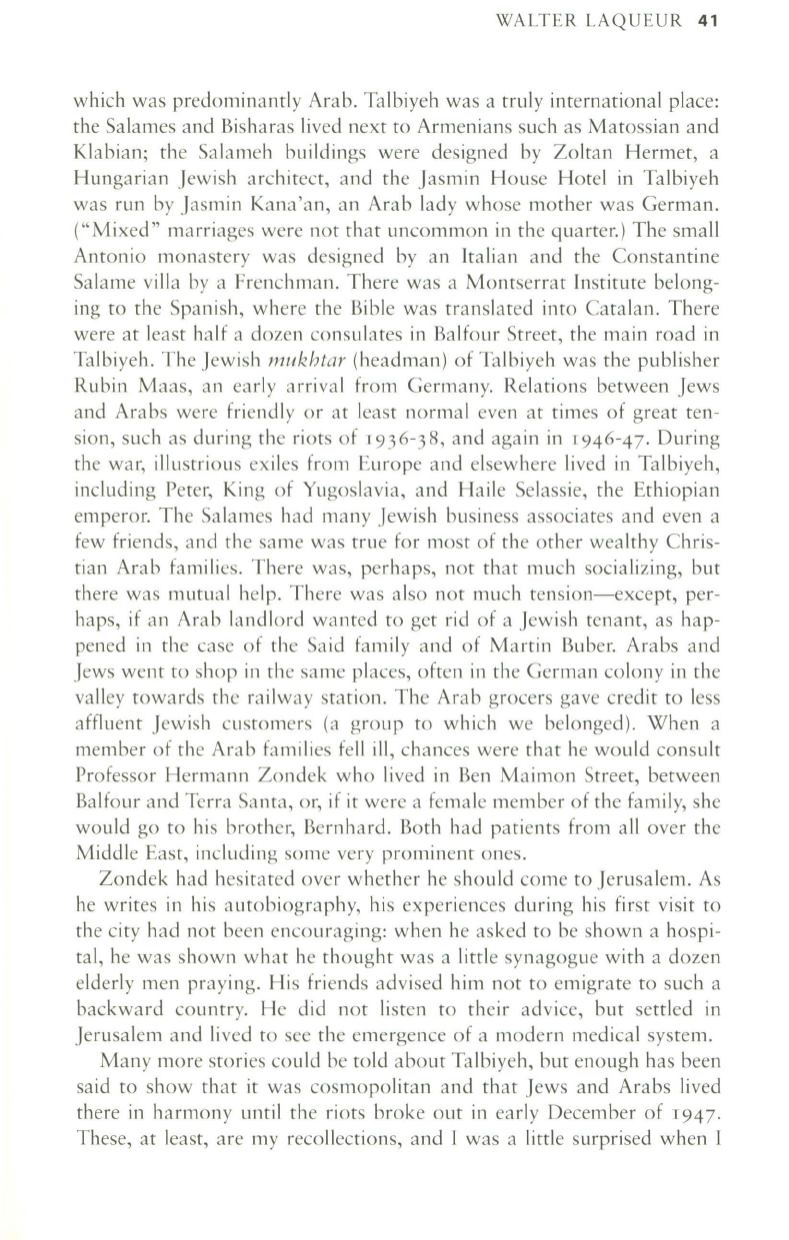
WALTER LAQUEUR
41
which was predominantly Arab. Talbiyeh was a truly international place:
the Salames and Bisharas lived next to Armenians such as Matossian and
Klabian; the Salameh buildings were designed by Zoltan Hermet, a
Hungarian Jewish architect, and the Jasmin House Hotel in Talbiyeh
was run by Jasmin Kana'an, an Arab lady whose mother was German.
("Mixed" marriages were not that uncommon in the quarter.) The small
Antonio monastery was designed by an Italian and the Constantine
Salame villa by a Frenchman. There was a Montserrat Institute belong–
ing to the Spanish, where the Bible was translated into Catalan. There
were at least half a dozen consulates in Balfour Street, the main road in
Talbiyeh. The Jewish
mukhtar
(headman) of Talbiyeh was the publisher
Rubin Maas, an early arrival from Germany. Relations between Jews
and Arabs were friendly or at least normal even at times of great ten–
sion, such as during the riots of
1936-38,
and again in
1946-47.
During
the war, illustrious exiles from Europe and elsewhere lived in Talbiyeh,
including Peter, King of Yugoslavia, and Haile Selassie, the Ethiopian
emperor. The Salames had many Jewish business associates and even a
few friends, and the same was true for most of the other wealthy Chris–
tian Arab families. There was, perhaps, not that much socializing, but
there was mutual help. There was also not much tension-except, per–
haps, if an Arab landlord wanted to get rid of a Jewish tenant, as hap–
pened in the case of the Said family and of Martin Buber. Arabs and
Jews went to shop in the same places, often in the German colony in the
valley towards the railway station. The Arab grocers gave credit to less
affluent Jewish customers (a group to which we belonged). When a
member of the Arab families fell ill, chances were that he would consult
Professor Hermann Zondek who lived in Ben Maimon Street, between
Balfour and Terra Santa, or, if it were a female member of the family, she
would go to his brother, Bernhard. Both had patients from all over the
Middle East, including some very prominent ones.
Zondek had hesitated over whether he should come to Jerusalem. As
he writes in his autobiography, his experiences during his first visit to
the city had not been encouraging: when he asked to be shown a hospi–
tal, he was shown what he thought was a little synagogue with a dozen
elderly men praying. His friends advised him not to emigrate to such a
backward country. He did not listen to their advice, but settled in
Jerusalem and lived to see the emergence of a modern medical system.
Many more stories could be told about Talbiyeh, but enough has been
said to show that it was cosmopolitan and that Jews and Arabs lived
there in harmony until the riots broke out in early December of
1947.
These, at least, are my recollections, and I was a little surprised when I


